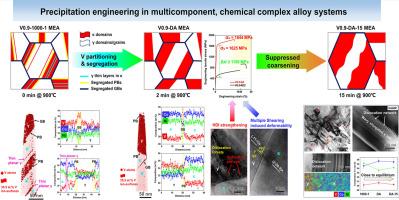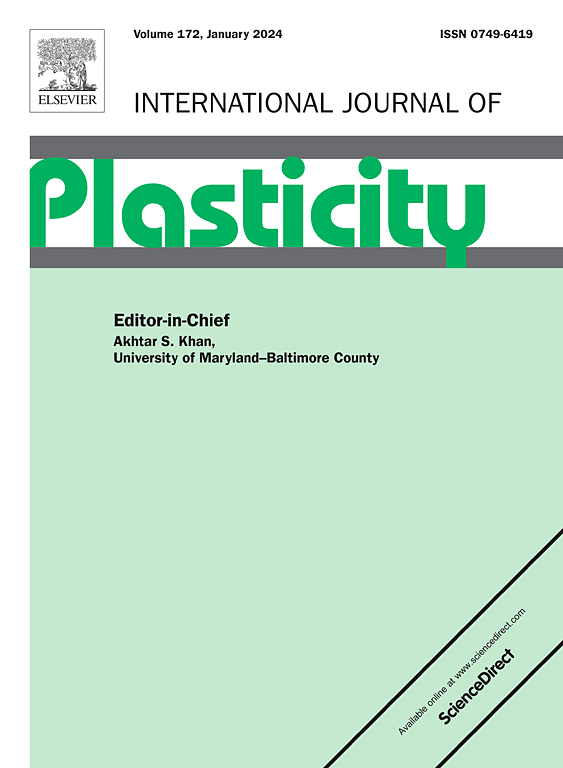通过沉淀工程显著提高镍钴钒中熵合金的机械性能
IF 9.4
1区 材料科学
Q1 ENGINEERING, MECHANICAL
引用次数: 0
摘要
析出工程是提高合金强度的最有效手段之一,它主要要求析出物具有一定的变形能力、细小尺寸和均匀分布。然而,对于多组分合金体系来说,由于潜在析出相的多样性和脆性,化学复杂性给应用这种强化方法带来了很大困难。在这项工作中,我们展示了化学性质复杂的原型合金 NiCoV 的沉淀工程。具体来说,通过降低 V 含量避免了有害的 σ、μ 和 Heusler 相的形成,并设计了两步短期退火来引发均匀的 κ 成核,同时抑制其快速粗化。研究发现,晶界和相界都会捕获 V 原子,这不仅会对这些界面造成销蚀,还会阻碍κ生长所需的 V 分配。因此,我们在 NiCoV0.9 合金中实现了超精细的 κ/γ 结构,并出人意料地表现出 1.6 GPa 的超高屈服强度和 219 MPa 的总加工硬化量。我们的分析表明,异质变形诱导应力(HDI)是产生高强度的主要原因,而相界的一致性和 κ 的良好变形性缓解了应力集中,从而产生了明显的加工硬化。我们的研究工作强调了在沉淀工程中选择合适的相和定制精细的子结构的重要性,其主要发现也有助于提高其他多组分合金的整体机械性能。本文章由计算机程序翻译,如有差异,请以英文原文为准。

Significantly enhanced mechanical properties of NiCoV medium-entropy alloy via precipitation engineering
Precipitation engineering is one of the most effective means to enhance the strength of an alloy, which essentially requires precipitates with certain deformability, fine size, and uniform distribution. However, for multicomponent alloy systems, the chemical complexity poses significant difficulties in applying this strengthening method due to the diversity and brittleness of the potential precipitate phases. In this work, we demonstrated the precipitation engineering in a chemically complex prototype alloy NiCoV. Specifically, formation of detrimental σ, μ and Heusler phases was avoided by reducing the V content, and a two-step short-term annealing was designed to trigger homogeneous κ nucleation while inhibiting its rapid coarsening. It is found that both grain and phase boundaries can trap V atoms, which not only pins these interfaces but also hinders the V partitioning needed for κ growth. Consequently, we achieved an ultrafine κ/γ architecture in the NiCoV0.9 alloy, which surprisingly exhibited an ultrahigh yield strength of 1.6 GPa and a total work-hardening amount of 219 MPa. Our analysis indicates that the hetero-deformation induced (HDI) stress is mainly responsible for the high strength, while the coherent nature of phase boundaries and decent deformability of κ alleviate stress concentration, giving rise to the pronounced work-hardening. Our work highlights the importance of suitable phase selection and delicate substructure tailoring in precipitation engineering, with key findings also useful for enhancing overall mechanical properties in other multicomponent alloys.
求助全文
通过发布文献求助,成功后即可免费获取论文全文。
去求助
来源期刊

International Journal of Plasticity
工程技术-材料科学:综合
CiteScore
15.30
自引率
26.50%
发文量
256
审稿时长
46 days
期刊介绍:
International Journal of Plasticity aims to present original research encompassing all facets of plastic deformation, damage, and fracture behavior in both isotropic and anisotropic solids. This includes exploring the thermodynamics of plasticity and fracture, continuum theory, and macroscopic as well as microscopic phenomena.
Topics of interest span the plastic behavior of single crystals and polycrystalline metals, ceramics, rocks, soils, composites, nanocrystalline and microelectronics materials, shape memory alloys, ferroelectric ceramics, thin films, and polymers. Additionally, the journal covers plasticity aspects of failure and fracture mechanics. Contributions involving significant experimental, numerical, or theoretical advancements that enhance the understanding of the plastic behavior of solids are particularly valued. Papers addressing the modeling of finite nonlinear elastic deformation, bearing similarities to the modeling of plastic deformation, are also welcomed.
 求助内容:
求助内容: 应助结果提醒方式:
应助结果提醒方式:


